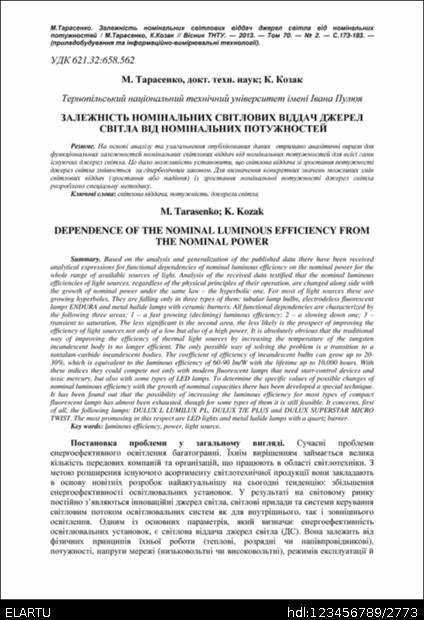Будь ласка, використовуйте цей ідентифікатор, щоб цитувати або посилатися на цей матеріал:
http://elartu.tntu.edu.ua/handle/123456789/2773

Повний запис метаданих
| Поле DC | Значення | Мова |
|---|---|---|
| dc.contributor.author | Тарасенко, Микола Григорович | - |
| dc.contributor.author | Козак, Катерина Миколаївна | - |
| dc.contributor.author | Tarasenko, M. | - |
| dc.contributor.author | Kozak, K. | - |
| dc.date.accessioned | 2014-02-03T08:41:15Z | - |
| dc.date.available | 2014-02-03T08:41:15Z | - |
| dc.date.issued | 2013-03-18 | - |
| dc.identifier.citation | М.Тарасенко. Залежність номінальних світлових віддач джерел світла від номінальних потужностей / М.Тарасенко, К.Козак // Вісник ТНТУ. — 2013. — Том 70. — № 2. — С.173-183. — (приладобудування та інформаційно-вимірювальні технології). | uk |
| dc.identifier.issn | 1727-7108 | - |
| dc.identifier.uri | http://elartu.tntu.edu.ua/handle/123456789/2773 | - |
| dc.description.abstract | На основі аналізу та узагальнення опублікованих даних отримано аналітичні вирази для функціональних залежностей номінальних світлових віддач від номінальних потужностей для всієї гами існуючих джерел світла. Це дало можливість установити, що світлова віддача зі зростання потужності джерел світла змінюється за гіперболічним законом. Для визначення конкретних значень можливих змін світлових віддач (зростання або падіння) із зростання номінальної потужності джерел світла розроблено спеціальну методику. | uk |
| dc.description.abstract | Based on the analysis and generalization of the published data there have been received analytical expressions for functional dependencies of nominal luminous efficiency on the nominal power for the whole range of available sources of light. Analysis of the received data testified that the nominal luminous efficiencies of light sources, regardless of the physical principles of their operation, are changed along side with the growth of nominal power under the same law – the hyperbolic one. For most of light sources these are growing hyperboles. They are falling only in three types of them: tubular lamp bulbs, electrodeless fluorescent lamps ENDURA and metal halide lamps with ceramic burners. All functional dependencies are characterized by the following three areas: 1 – a fast growing (declining) luminous efficiency; 2 – a slowing down one; 3 – transient to saturation. The less significant is the second area, the less likely is the prospect of improving the efficiency of light sources not only of a low but also of a high power. It is absolutely obvious that the traditional way of improving the efficiency of thermal light sources by increasing the temperature of the tungsten incandescent body is no longer efficient. The only possible way of solving the problem is a transition to a tantalum-carbide incandescent bodies. The coefficient of efficiency of incandescent bulbs can grow up to 20-30%, which is equivalent to the luminous efficiency of 60-90 lm/W with the lifetime up to 10,000 hours. With these indices they could compete not only with modern fluorescent lamps that need start-control devices and toxic mercury, but also with some types of LED lamps. To determine the specific values of possible changes of nominal luminous efficiency with the growth of nominal capacities there has been developed a special technique. It has been found out that the possibility of increasing the luminous efficiency for most types of compact fluorescent lamps has almost been exhausted, though for some types of them it is still feasible. It concerns, first of all, the following lamps: DULUX L LUMILUX PL, DULUX T/E PLUS and DULUX SUPERSTAR MICRO TWIST. The most promosing in this respect are LED lights and metal halide lamps with a quartz burner. | uk |
| dc.language.iso | uk | uk |
| dc.publisher | Тернопільський національний технічний університет ім. Івана Пулюя | uk |
| dc.subject | світлова віддача | uk |
| dc.subject | потужність | uk |
| dc.subject | джерела світла | uk |
| dc.subject | luminous efficiency | uk |
| dc.subject | power | uk |
| dc.subject | light source | uk |
| dc.title | Залежність номінальних світлових віддач джерел світла від номінальних потужностей | uk |
| dc.title.alternative | Dependence of the nominal luminous efficiency from the nominal power | uk |
| dc.type | Article | uk |
| dc.rights.holder | © „Вісник Тернопільського національного технічного університету“ | uk |
| dc.coverage.placename | Тернопіль, Україна | uk |
| dc.status | Опубліковано раніше | uk |
| dc.subject.udc | 621.32 | uk |
| dc.subject.udc | 658.562 | uk |
| Розташовується у зібраннях: | Вісник ТНТУ, 2013, № 2 (70) | |
Файли цього матеріалу:
Усі матеріали в архіві електронних ресурсів захищені авторським правом, всі права збережені.